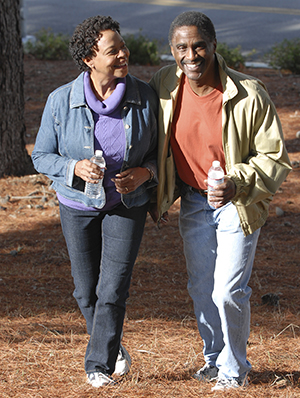Living with Osteoarthritis
Osteoarthritis is a long-term (chronic) disease. It's the most common type of arthritis. But it doesn’t have to keep you from leading an active life. You can help control your symptoms. Exercising and losing excess weight will help. Using special tools can help make life easier. See your healthcare provider for regular checkups and blood tests.
Make exercise part of your life

Gentle exercise can help lessen your pain. Make sure to:
-
Choose exercises that improve joint motion and make your muscles stronger. Talk with your healthcare provider or a physical therapist for exercises that may help.
-
Try stretching and flexibility activities, such as yoga and tai chi. These may decrease pain and improve joint motion.
-
Try low-impact sports. These include walking, biking, or doing exercises in a warm pool.
-
Most people should exercise for at least 30 minutes a day on most days of the week. This can be broken up into shorter periods during the day.
-
Don’t push yourself too hard at first. Slowly build up over time.
-
Warm up for 5 to 10 minutes before you exercise.
-
If pain and stiffness get worse, don't exercise as hard or as long.
Watch your weight
If you weigh more than you should, your weight-bearing joints are under extra pressure. This makes your symptoms worse. To reduce pain and stiffness, make a plan to lose the extra pounds. These tips may help:
-
Start a weight-loss program. Talk with your healthcare provider or nutritionist.
-
Ask your friends and family for support.
-
Join a weight-loss group.
Use special tools
Even simple tasks can be hard to do when your joints hurt. Special tools called assistive devices can make things easier. They reduce strain and protect your joints. Ask your provider where to find tools, such as:
-
Long-handled reachers or grabbers
-
Jar openers
-
Button threaders
-
Large grips for pencils, garden tools, and other handheld objects
Use mobility aids and other tools
People with arthritis and other joint problems often use mobility aids to help with walking. They may use canes or walkers. They may use splints or braces to support joints. These devices need to be adjusted to support your physical needs (for instance, your height or type of joint deformity). So talk with your healthcare provider or physical therapist before buying a product. Ask about these aids:
-
A cane to reduce knee or hip pain and help prevent falls
-
Splints for your wrists or other joints
-
A brace to support a weak knee joint
-
Orthotics for toe and foot problems
Types of treatments
Talk with your healthcare provider about the many types of treatments that may help reduce your pain and improve joint mobility. These may include:
-
Medicines put right on the skin (topical). These include lidocaine, capsaicin, and diclofenac gel.
-
Medicines taken by mouth (oral). These include acetaminophen, nonsteroidal anti-inflammatory drugs (NSAIDs), such as ibuprofen and naproxen, or opioids.
-
Medicines injected directly into joints. These include corticosteroids, or hyaluronic acid in the knee joints.
-
Surgery to repair a joint
-
Surgery to replace a joint with an artificial joint
Complementary therapies can help. Talk with your provider about these choices:
Online Medical Reviewer:
Dan Brennan MD
Online Medical Reviewer:
Marianne Fraser MSN RN
Online Medical Reviewer:
Rita Sather RN
Date Last Reviewed:
3/1/2024
© 2000-2025 The StayWell Company, LLC. All rights reserved. This information is not intended as a substitute for professional medical care. Always follow your healthcare professional's instructions.